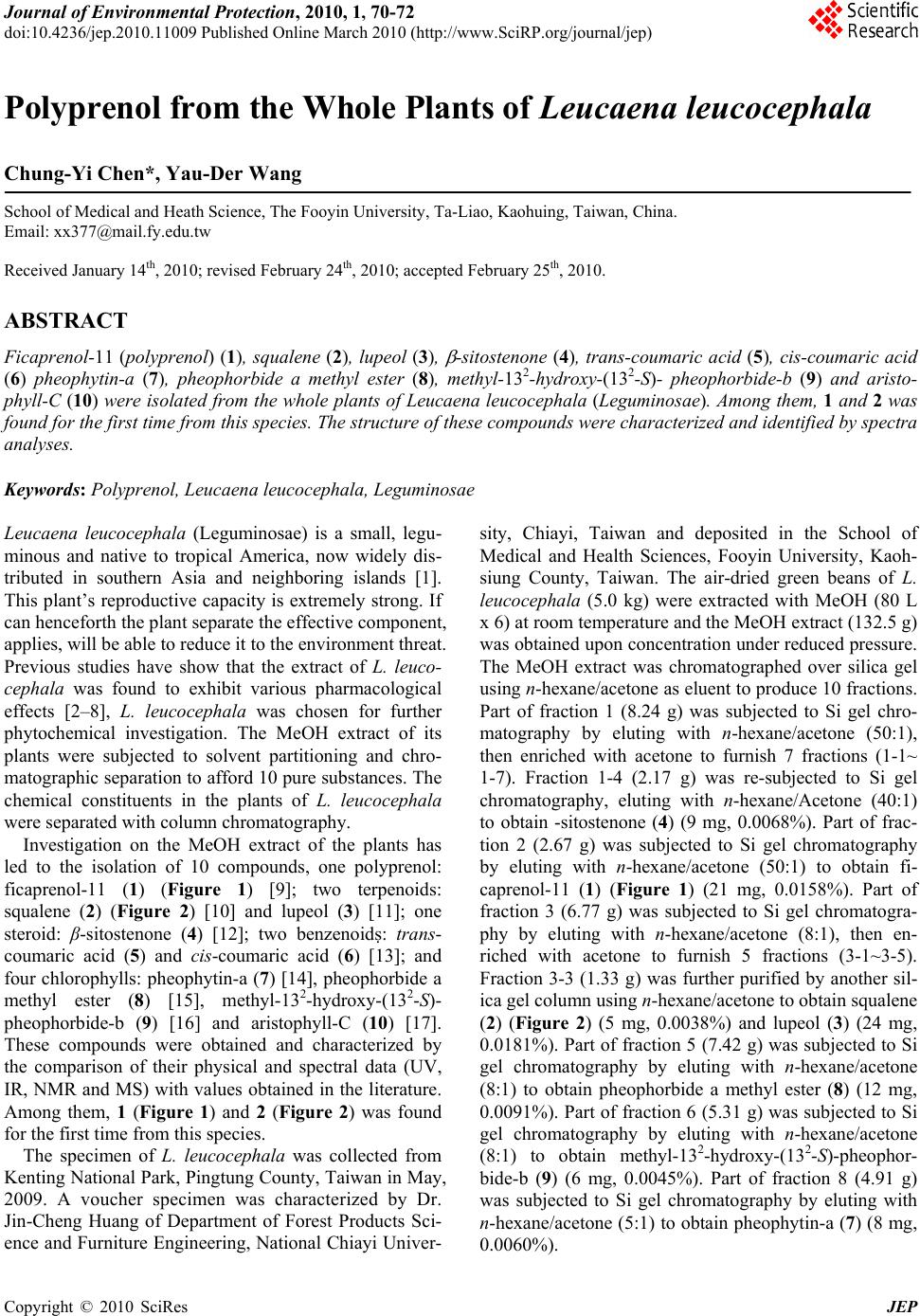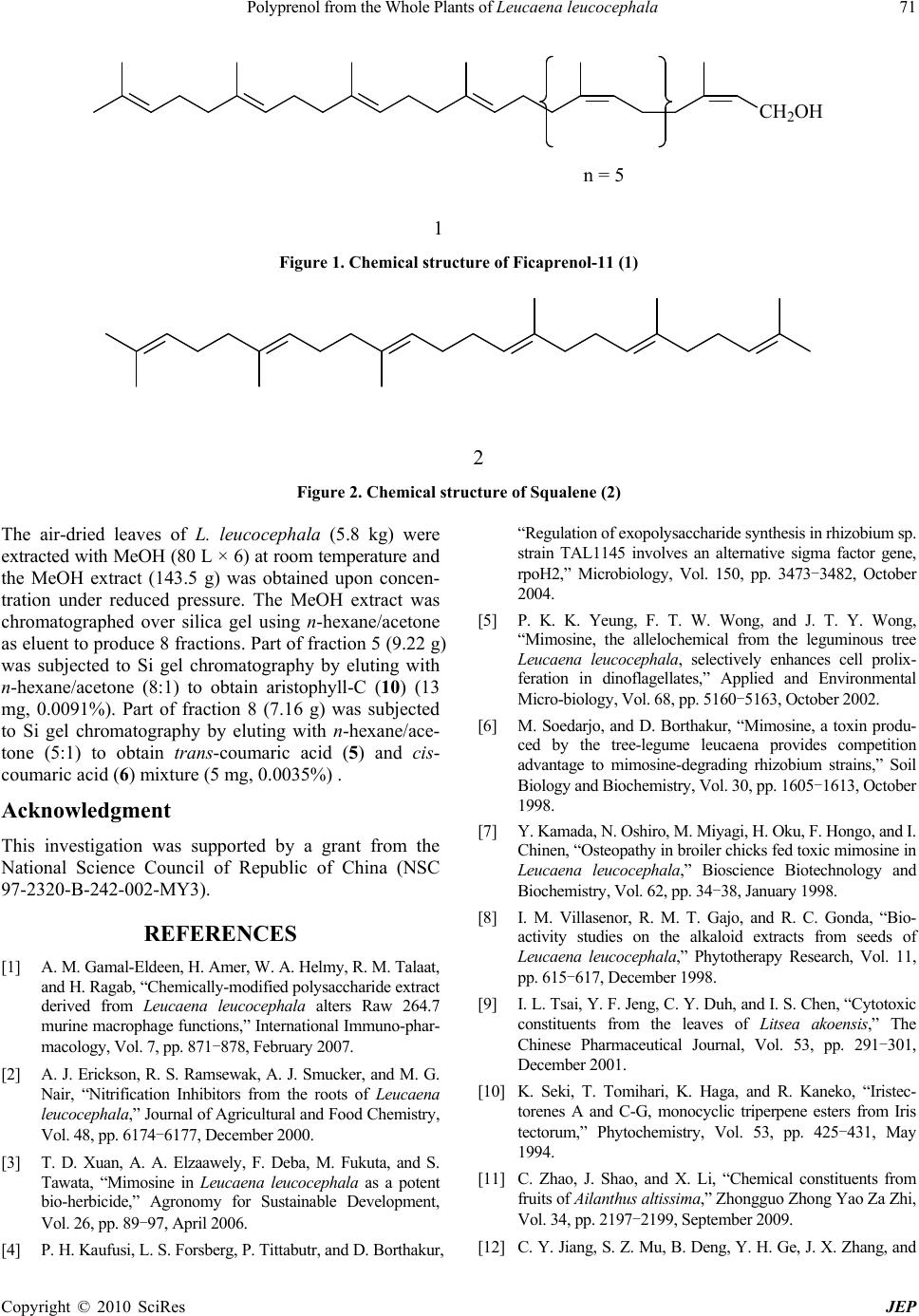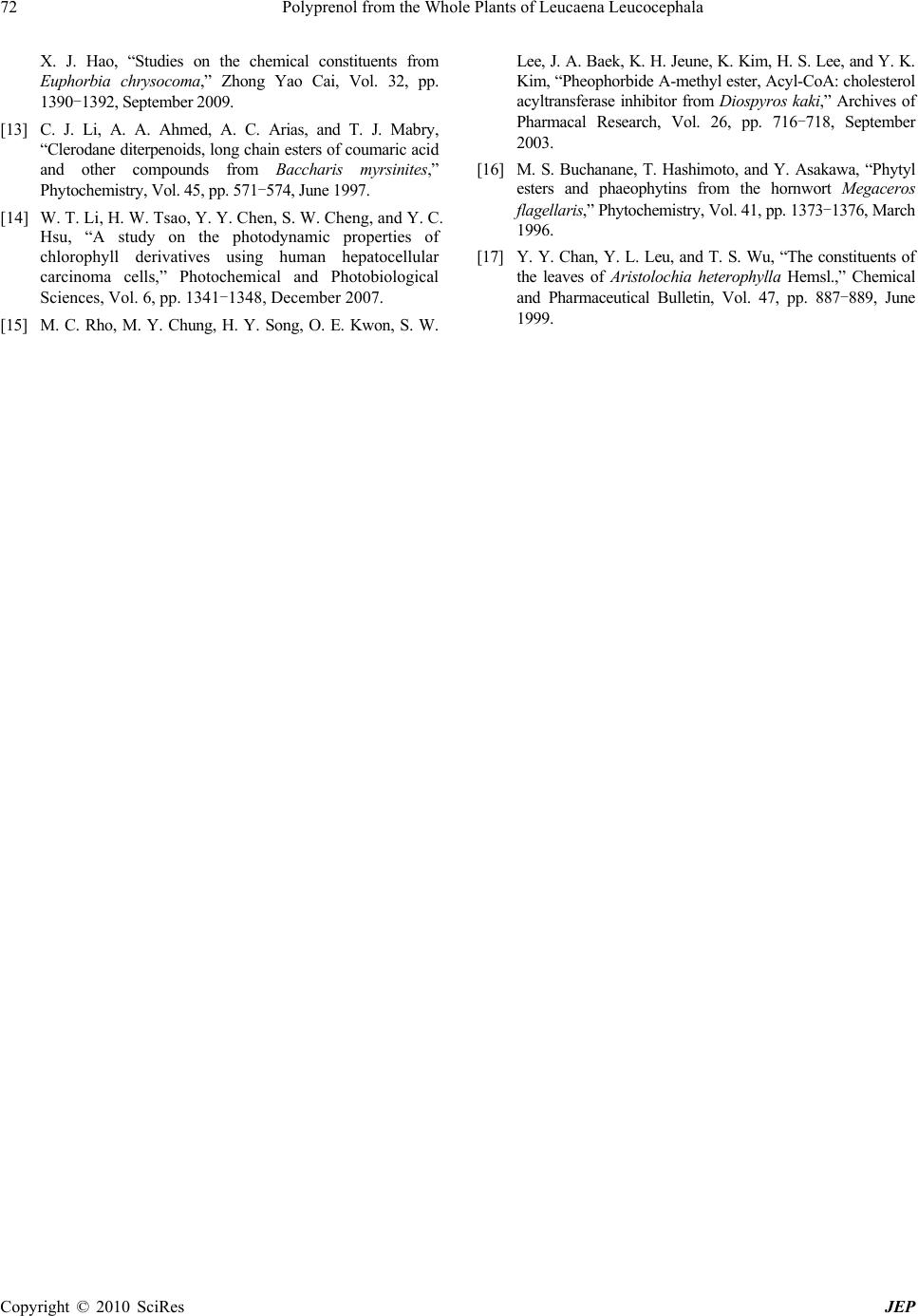Paper Menu >>
Journal Menu >>
 Journal of Environmental Protection, 2010, 1, 70-72 doi:10.4236/jep.2010.11009 Published Online March 2010 (http://www.SciRP.org/journal/jep) Copyright © 2010 SciRes JEP Polyprenol from the Whole Plants of Leucaena leucocephala Chung-Yi Chen*, Yau-Der Wang School of Medical and Heath Science, The Fooyin University, Ta-Liao, Kaohuing, Taiwan, China. Email: xx377@mail.fy.edu.tw Received January 14th, 2010; revised February 24th, 2010; accepted February 25th, 2010. ABSTRACT Ficaprenol-11 (polyprenol) (1), squalene (2), lupeol (3), -sitostenone (4), trans-coumaric acid (5), cis-coumaric acid (6) pheophytin-a (7), pheophorbide a methyl ester (8), methyl-132-hydroxy-(132-S)- pheophorbide-b (9) and aristo- phyll-C (10) were isolated from the whole plants of Leucaena leucocephala (Leguminosae). Among them, 1 and 2 was found for the first time from this species. The structure of these compounds were characterized and identified by spectra analyses. Keywords: Polyprenol, Leucaena leucocephala, Leguminosae Leucaena leucocephala (Leguminosae) is a small, legu- minous and native to tropical America, now widely dis- tributed in southern Asia and neighboring islands [1]. This plant’s reproductive capacity is extremely strong. If can henceforth the plant separate the effective component, applies, will be able to reduce it to the environment threat. Previous studies have show that the extract of L. leuco- cephala was found to exhibit various pharmacological effects [2–8], L. leucocephala was chosen for further phytochemical investigation. The MeOH extract of its plants were subjected to solvent partitioning and chro- matographic separation to afford 10 pure substances. The chemical constituents in the plants of L. leucocephala were separated with column chromatography. Investigation on the MeOH extract of the plants has led to the isolation of 10 compounds, one polyprenol: ficaprenol-11 (1) (Figure 1) [9]; two terpenoids: squalene (2) (Figure 2) [10] and lupeol (3) [11]; one steroid: β-sitostenone (4) [12]; two benzenoids: trans- coumaric acid (5) and cis-coumaric acid (6) [13]; and four chlorophylls: pheophytin-a (7) [14], pheophorbide a methyl ester (8) [15], methyl-132-hydroxy-(132-S)- pheophorbide-b (9) [16] and aristophyll-C (10) [17]. These compounds were obtained and characterized by the comparison of their physical and spectral data (UV, IR, NMR and MS) with values obtained in the literature. Among them, 1 (Figure 1) and 2 (Figure 2) was found for the first time from this species. The specimen of L. leucocephala was collected from Kenting National Park, Pingtung County, Taiwan in May, 2009. A voucher specimen was characterized by Dr. Jin-Cheng Huang of Department of Forest Products Sci- ence and Furniture Engine ering, National Chiayi Univer- sity, Chiayi, Taiwan and deposited in the School of Medical and Health Sciences, Fooyin University, Kaoh- siung County, Taiwan. The air-dried green beans of L. leucocephala (5.0 kg) were extracted with MeOH (80 L x 6) at room temperature and the MeOH extract (132.5 g) was obtained upon concentration und er reduced pressure. The MeOH extract was chromatographed over silica gel using n-hexane/acetone as eluent to produce 10 fractions. Part of fraction 1 (8.24 g) was subjected to Si gel chro- matography by eluting with n-hexane/acetone (50:1), then enriched with acetone to furnish 7 fractions (1-1~ 1-7). Fraction 1-4 (2.17 g) was re-subjected to Si gel chromatography, eluting with n-hexane/Acetone (40:1) to obtain -sitostenone (4) (9 mg, 0.0068%). Part of frac- tion 2 (2.67 g) was subjected to Si gel chromatography by eluting with n-hexane/acetone (50:1) to obtain fi- caprenol-11 (1) (Figure 1) (21 mg, 0.0158%). Part of fraction 3 (6.77 g) was subjected to Si gel chromatogra- phy by eluting with n-hexane/acetone (8:1), then en- riched with acetone to furnish 5 fractions (3-1~3-5). Fraction 3-3 (1.33 g) was further purified by another sil- ica gel column using n-hexane/acetone to obtain squalene (2) (Figure 2) (5 mg, 0.0038%) and lupeol (3) (24 mg, 0.0181%). Part of fraction 5 (7.42 g) was subjected to Si gel chromatography by eluting with n-hexane/acetone (8:1) to obtain pheophorbide a methyl ester (8) (12 mg, 0.0091%). Part of fraction 6 (5.31 g) was subjected to Si gel chromatography by eluting with n-hexane/acetone (8:1) to obtain methyl-132-hydroxy-(132-S)-pheopho r- bide-b (9) (6 mg, 0.0045%). Part of fraction 8 (4.91 g) was subjected to Si gel chromatography by eluting with n-hexane/acetone (5:1) to obtain pheophytin-a (7) (8 mg, 0.0060%).  Polyprenol from the Whole Plants of Leucaena leucocephala 71 Copyright © 2010 SciRes JEP CH2OH n = 5 1 Figure 1. Chemical structure of Ficaprenol-11 (1) 2 Figure 2. Chemical struct ur e of Squale ne (2) The air-dried leaves of L. leucocephala (5.8 kg) were extracted with MeOH (80 L × 6) at room tempera ture and the MeOH extract (143.5 g) was obtained upon concen- tration under reduced pressure. The MeOH extract was chromatographed over silica gel using n-hexane/acetone as eluent to produce 8 fractions. Part of fraction 5 (9.22 g) was subjected to Si gel chromatography by eluting with n-hexane/acetone (8:1) to obtain aristophyll-C (10) (13 mg, 0.0091%). Part of fraction 8 (7.16 g) was subjected to Si gel chromatography by eluting with n-hexane/ace- tone (5:1) to obtain trans-coumaric acid (5) and cis- coumaric acid (6) mixture (5 mg, 0.0035%) . Acknowledgment This investigation was supported by a grant from the National Science Council of Republic of China (NSC 97-2320-B-242-002-MY3). REFERENCES [1] A. M. Ga mal-Eldeen, H. Amer, W. A. Helmy , R. M. Talaat, and H. Ragab, “Che mically-modified poly saccha ride extract derived from Leucaena leucocephala alters Raw 264.7 murine macropha ge functions,” Internationa l Immuno-phar- macology, Vol. 7, pp. 871-878, February 2007. [2] A. J. Erickson, R . S. Ramsewa k, A. J. Smucker, and M. G. Nair, “Nitrification Inhibitors from the roots of Leucaena leucocephala,” Journal of Agr icultural a nd Food Che mistry, Vol. 48, pp. 6174-6177, December 2000. [3] T. D. Xuan, A. A. Elzaawely, F. Deba, M. Fukuta, and S. Tawata, “Mimosine in Leucaena leucocephala as a potent bio-herbicide,” Agronomy for Sustainable Development, Vol. 26, pp. 89-97, Ap ril 2006. [4] P. H. Kaufusi, L. S. Forsberg, P. Tittabutr, and D. Borthakur, “Regulation of exopolysaccharide synthesis in rhizobium sp. strain TAL1145 involves an alternative sigma factor gene, rpoH2,” Microbiology, Vol. 150, pp. 3473-3482, October 2004. [5] P. K. K. Yeung, F. T. W. Wong, and J. T. Y. Wong, “Mimosine, the allelochemical from the leguminous tree Leucaena leucocephala, selectively enhances cell prolix- feration in dinoflagellates,” Applied and Environmental Micro-biolo gy, Vol. 68 , pp. 5160 -5163, October 2002. [6] M. Soedarjo, and D. Borthakur, “Mimosine, a toxin produ- ced by the tree-legume leucaena provides competition advantage to mimosine-degrading rhizobium strains,” Soil Biology and Biochemistry, Vol. 30, pp. 16 05-1613, October 1998. [7] Y. Kamada, N. Oshiro, M. Miyagi, H. Oku, F. Hongo, and I. Chinen, “Osteopathy in broiler chicks fed toxic mimosine in Leucaena leucocephala,” Bioscience Biotechnology and Biochemi stry, Vol. 62, pp. 34-38, January 1998. [8] I. M. Villasenor, R. M. T. Gajo, and R. C. Gonda, “Bio- activity studies on the alkaloid extracts from seeds of Leucaena leucocephala,” Phytotherapy Research, Vol. 11, pp. 615-617, December 1998. [9] I. L. Tsai, Y. F. Jeng, C. Y. Duh, and I. S. Chen, “Cytotoxic constituents from the leaves of Litsea akoensis,” The Chinese Pharmaceutical Journal, Vol. 53, pp. 291-301, December 2001. [10] K. Seki, T. Tomihari, K. Haga, and R. Kaneko, “Iristec- torenes A and C-G, monocyclic triperpene esters from Iris tectorum,” Phytochemistry, Vol. 53, pp. 425-431, May 1994. [11] C. Zhao, J. Shao, and X. Li, “Chemical constituents from fruits of Ailanthus altissima,” Zhongguo Zhong Yao Za Zhi, Vol. 34, pp. 2197-2199, September 2009. [12] C. Y. Jia ng, S. Z. Mu, B. Deng, Y. H. Ge, J. X. Zh ang, and  72 Polyprenol from the Whole Plants of Leucaena Leucocephala Copyright © 2010 SciRes JEP X. J. Hao, “Studies on the chemical constituents from Euphorbia chrysocoma,” Zhong Yao Cai, Vol. 32, pp. 1390-1392, September 2009. [13] C. J. Li, A. A. Ahmed, A. C. Arias, and T. J. Mabry, “Clerodane diterpen oids, long chain esters of couma ric acid and other compounds from Baccharis myrsinites,” Phytochemistry, Vol. 45, pp. 571-574, June 1997. [14] W. T. Li, H. W. Tsao, Y. Y. Chen, S. W. Cheng, and Y. C. Hsu, “A study on the photodynamic properties of chlorophyll derivatives using human hepatocellular carcinoma cells,” Photochemical and Photobiological Sciences, Vol. 6, pp. 1341-1348, December 2007. [15] M. C. Rho, M. Y. Chung, H. Y. Song, O. E. Kwon, S. W. Lee, J. A. Baek, K. H. Jeu ne, K. Kim, H. S. Lee, and Y. K. Kim, “Pheop horbide A-methy l ester, Acyl-Co A: choleste rol acyltransferase inhibitor from Diospyros kaki,” Archives of Pharmacal Research, Vol. 26, pp. 716-718, September 2003. [16] M. S. Buchanane, T. Hashimoto, and Y. Asakawa, “Phytyl esters and phaeophytins from the hornwort Megaceros flagellaris,” Phytochemistry, Vol. 41, pp. 1373-1376, March 1996. [17] Y. Y. Chan, Y. L. Leu, and T. S. Wu, “The constituents of the leaves of Aristolochia heterophylla Hemsl.,” Chemical and Pharmaceutical Bulletin, Vol. 47, pp. 887-889, June 1999. |

